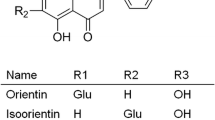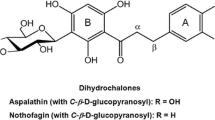Abstract
Hyperoside, an active compound from the genera of Hypericum and Crataegus, was reported to have antioxidant, antihyperglycemic, anticancer, anti-inflammatory, and anticoagulant activities. Vascular inflammatory process has been suggested to play a key role in initiation and progression of atherosclerosis, a major complication of diabetes mellitus. Thus, in this study, we attempted to determine whether hyperoside can suppress vascular inflammatory processes induced by high glucose (HG) in human umbilical vein endothelial cells (HUVECs) and mice. Data showed that HG induced markedly increased vascular permeability, monocyte adhesion, expressions of cell adhesion molecules (CAMs), formation of reactive oxygen species (ROS), and activation of nuclear factor (NF)-κB. Remarkably, all of the above-mentioned vascular inflammatory effects of HG were attenuated by pretreatment with hyperoside. Vascular inflammatory responses induced by HG are critical events underlying development of various diabetic complications; therefore, our results suggest that hyperoside may have significant therapeutic benefits against diabetic complications and atherosclerosis.






Similar content being viewed by others
References
Whiting, D.R., L. Guariguata, C. Weil, and J. Shaw. 2011. IDF diabetes atlas: global estimates of the prevalence of diabetes for 2011 and 2030. Diabetes Research and Clinical Practice 94: 311–321.
Grundy, S.M., I.J. Benjamin, G.L. Burke, et al. 1999. Diabetes and cardiovascular disease: a statement for healthcare professionals from the American Heart Association. Circulation 100: 1134–1146.
Thomas, J.E., and J.M. Foody. 2007. The pathophysiology of cardiovascular disease in diabetes mellitus and the future of therapy. Journal of the Cardiometabolic Syndrome 2: 108–113.
Roglic, G., N. Unwin, P.H. Bennett, et al. 2005. The burden of mortality attributable to diabetes: realistic estimates for the year 2000. Diabetes Care 28: 2130–2135.
Rubino, F., and M. Gagner. 2002. Potential of surgery for curing type 2 diabetes mellitus. Annals of Surgery 236: 554–559.
Holman, R., and R. Turner. 1991. Oral Agents and Insulin. Textbook of Diabetes 462–476.
Li, G.Q., A. Kam, K.H. Wong, et al. 2012. Herbal medicines for the management of diabetes. Advances in Experimental Medicine and Biology 771: 396–413.
Day, C. 1998. Traditional plant treatments for diabetes mellitus: pharmaceutical foods. British Journal of Nutrition 80: 5–6.
Aggarwal, B.B., H. Ichikawa, P. Garodia, et al. 2006. From traditional Ayurvedic medicine to modern medicine: identification of therapeutic targets for suppression of inflammation and cancer. Expert Opinion on Therapeutic Targets 10: 87–118.
Bae, J.S. 2012. Role of high mobility group box 1 in inflammatory disease: focus on sepsis. Archives of Pharmacal Research 35: 1511–1523.
Middleton Jr., E., and G. Drzewiecki. 1984. Flavonoid inhibition of human basophil histamine release stimulated by various agents. Biochemical Pharmacology 33: 3333–3338.
Mukaida, N. 2000. Interleukin-8: an expanding universe beyond neutrophil chemotaxis and activation. International Journal of Hematology 72: 391–398.
Hirano, T., S. Higa, J. Arimitsu, et al. 2006. Luteolin, a flavonoid, inhibits AP-1 activation by basophils. Biochemical and Biophysical Research Communications 340: 1–7.
Zou, Y., Y. Lu, and D. Wei. 2004. Antioxidant activity of a flavonoid-rich extract of Hypericum perforatum L. in vitro. Journal of Agricultural and Food Chemistry 52: 5032–5039.
Zhou, W., J. Oh, W. Li, D.W. Kim, S.H. Lee, and M. Na. 2013. Phytochemical studies of Korean endangered plants: a new flavone from Rhododendron brachycarpum G. Don. Bulletin of the Korean Chemical Society 34: 2535–2538.
Verma, N., G. Amresh, P.K. Sahu, N. Mishra, V. Rao Ch, and A.P. Singh. 2013. Pharmacological evaluation of hyperin for antihyperglycemic activity and effect on lipid profile in diabetic rats. Indian Journal of Experimental Biology 51: 65–72.
Li, F.R., F.X. Yu, S.T. Yao, Y.H. Si, W. Zhang, and L.L. Gao. 2012. Hyperin extracted from Manchurian rhododendron leaf induces apoptosis in human endometrial cancer cells through a mitochondrial pathway. Asian Pacific Journal of Cancer Prevention 13: 3653–3656.
Kim, S.J., J.Y. Um, and J.Y. Lee. 2011. Anti-inflammatory activity of hyperoside through the suppression of nuclear factor-κB activation in mouse peritoneal macrophages. American Journal of Chinese Medicine 39: 171–181.
Li, Z.L., J. Hu, Y.L. Li, et al. 2013. The effect of hyperoside on the functional recovery of the ischemic/reperfused isolated rat heart: potential involvement of the extracellular signal-regulated kinase 1/2 signaling pathway. Free Radical Biology and Medicine 57: 132–140.
Ku, S.K., T.H. Kim, S. Lee, S.M. Kim, and J.S. Bae. 2012. Antithrombotic and profibrinolytic activities of isorhamnetin-3-O-galactoside and hyperoside. Food and Chemical Toxicology 53C: 197–204.
Lee, W., S.K. Ku, and J.S. Bae. 2013. Emodin-6-O-beta-D-glucoside down-regulates endothelial protein C receptor shedding. Archives of Pharmacal Research 36: 1160–1165.
Bae, J.S., and A.R. Rezaie. 2013. Thrombin inhibits HMGB1-mediated proinflammatory signaling responses when endothelial protein C receptor is occupied by its natural ligand. BMB Reports 46: 544–549.
Bae, J.S., W. Lee, and A.R. Rezaie. 2012. Polyphosphate elicits proinflammatory responses that are counteracted by activated protein C in both cellular and animal models. Journal of Thrombosis and Haemostasis 10: 1145–1151.
Lee, J.D., J.E. Huh, G. Jeon, et al. 2009. Flavonol-rich RVHxR from Rhus verniciflua Stokes and its major compound fisetin inhibits inflammation-related cytokines and angiogenic factor in rheumatoid arthritic fibroblast-like synovial cells and in vivo models. International Immunopharmacology 9: 268–276.
Akeson, A.L., and C.W. Woods. 1993. A fluorometric assay for the quantitation of cell adherence to endothelial cells. Journal of Immunological Methods 163: 181–185.
Kim, I., S.O. Moon, S.H. Kim, H.J. Kim, Y.S. Koh, and G.Y. Koh. 2001. Vascular endothelial growth factor expression of intercellular adhesion molecule 1 (ICAM-1), vascular cell adhesion molecule 1 (VCAM-1), and E-selectin through nuclear factor-kappa B activation in endothelial cells. Journal of Biological Chemistry 276: 7614–7620.
Mackman, N., K. Brand, and T.S. Edgington. 1991. Lipopolysaccharide-mediated transcriptional activation of the human tissue factor gene in THP-1 monocytic cells requires both activator protein 1 and nuclear factor kappa B binding sites. Journal of Experimental Medicine 174: 1517–1526.
Laakso, M. 1999. Hyperglycemia and cardiovascular disease in type 2 diabetes. Diabetes 48: 937–942.
Kannel, W.B., and D.L. McGee. 1979. Diabetes and cardiovascular disease. The Framingham study. JAMA 241: 2035–2038.
Nannipieri, M., L. Rizzo, A. Rapuano, A. Pilo, G. Penno, and R. Navalesi. 1995. Increased transcapillary escape rate of albumin in microalbuminuric type II diabetic patients. Diabetes Care 18: 1–9.
Wardle, E.N. 1994. Vascular permeability in diabetics and implications for therapy. Diabetes Research and Clinical Practice 23: 135–139.
Tooke, J.E. 1995. Microvascular function in human diabetes. A physiological perspective. Diabetes 44: 721–726.
Gerrity, R.G. 1981. The role of the monocyte in atherogenesis: I. Transition of blood-borne monocytes into foam cells in fatty lesions. American Journal of Pathology 103: 181–190.
Esposito, C., G. Fasoli, A.R. Plati, et al. 2001. Long-term exposure to high glucose up-regulates VCAM-induced endothelial cell adhesiveness to PBMC. Kidney International 59: 1842–1849.
Hamuro, M., J. Polan, M. Natarajan, and S. Mohan. 2002. High glucose induced nuclear factor kappa B mediated inhibition of endothelial cell migration. Atherosclerosis 162: 277–287.
Morigi, M., S. Angioletti, B. Imberti, et al. 1998. Leukocyte-endothelial interaction is augmented by high glucose concentrations and hyperglycemia in a NF-κB-dependent fashion. Journal of Clinical Investigation 101: 1905–1915.
Lopes-Virella, M.F., and G. Virella. 1992. Immune mechanisms of atherosclerosis in diabetes mellitus. Diabetes 41(Suppl 2): 86–91.
Kado, S., T. Wakatsuki, M. Yamamoto, and N. Nagata. 2001. Expression of intercellular adhesion molecule-1 induced by high glucose concentrations in human aortic endothelial cells. Life Sciences 68: 727–737.
Hansson, G.K., and P. Libby. 2006. The immune response in atherosclerosis: a double-edged sword. Nature Reviews Immunology 6: 508–519.
Boisvert, W.A. 2004. Modulation of atherogenesis by chemokines. Trends in Cardiovascular Medicine 14: 161–165.
Inoguchi, T., P. Li, F. Umeda, et al. 2000. High glucose level and free fatty acid stimulate reactive oxygen species production through protein kinase C—dependent activation of NAD(P)H oxidase in cultured vascular cells. Diabetes 49: 1939–1945.
Dunlop, M. 2000. Aldose reductase and the role of the polyol pathway in diabetic nephropathy. Kidney International. Supplement 77: S3–S12.
Han, H.J., Y.J. Lee, S.H. Park, J.H. Lee, and M. Taub. 2005. High glucose-induced oxidative stress inhibits Na+/glucose cotransporter activity in renal proximal tubule cells. American Journal of Physiology. Renal Physiology 288: F988–F996.
van Acker, S.A., D.J. van den Berg, M.N. Tromp, et al. 1996. Structural aspects of antioxidant activity of flavonoids. Free Radical Biology and Medicine 20: 331–342.
Rice-Evans, C.A., N.J. Miller, and G. Paganga. 1996. Structure-antioxidant activity relationships of flavonoids and phenolic acids. Free Radical Biology and Medicine 20: 933–956.
Rimbach, G., G. Valacchi, R. Canali, and F. Virgili. 2000. Macrophages stimulated with IFN-gamma activate NF-kappa B and induce MCP-1 gene expression in primary human endothelial cells. Molecular Cell Biology Research Communications 3: 238–242.
Uemura, S., H. Matsushita, W. Li, et al. 2001. Diabetes mellitus enhances vascular matrix metalloproteinase activity: role of oxidative stress. Circulation Research 88: 1291–1298.
Heim, K.E., A.R. Tagliaferro, and D.J. Bobilya. 2002. Flavonoid antioxidants: chemistry, metabolism and structure-activity relationships. Journal of Nutrition and Biochemistry 13: 572–584.
Pandey, A.K., A.K. Mishra, and A. Mishra. 2012. Antifungal and antioxidative potential of oil and extracts derived from leaves of Indian spice plant Cinnamomum tamala. Cell Mol Biol (Noisy-le-grand) 58: 142–147.
Cao, G., E. Sofic, and R.L. Prior. 1997. Antioxidant and prooxidant behavior of flavonoids: structure-activity relationships. Free Radical Biology and Medicine 22: 749–760.
Kumar, S., A. Mishra, and A.K. Pandey. 2013. Antioxidant mediated protective effect of Parthenium hysterophorus against oxidative damage using in vitro models. BMC Complementary and Alternative Medicine 13: 120.
Leopoldini, M., N. Russo, S. Chiodo, and M. Toscano. 2006. Iron chelation by the powerful antioxidant flavonoid quercetin. Journal of Agricultural and Food Chemistry 54: 6343–6351.
Brown, J.E., H. Khodr, R.C. Hider, and C.A. Rice-Evans. 1998. Structural dependence of flavonoid interactions with Cu2+ ions: implications for their antioxidant properties. Biochemical Journal 330(Pt 3): 1173–1178.
Sekher Pannala, A., T.S. Chan, P.J. O’Brien, and C.A. Rice-Evans. 2001. Flavonoid B-ring chemistry and antioxidant activity: fast reaction kinetics. Biochemical and Biophysical Research Communications 282: 1161–1168.
Acknowledgments
This study was supported by the National Research Foundation of Korea (NRF) funded by the Korean government [MSIP] (Grant No. 2013-067053).
Conflict of Interest
The authors declare no conflicts of interest.
Author information
Authors and Affiliations
Corresponding author
Rights and permissions
About this article
Cite this article
Ku, SK., Kwak, S., Kwon, OJ. et al. Hyperoside Inhibits High-Glucose-Induced Vascular Inflammation In Vitro and In Vivo . Inflammation 37, 1389–1400 (2014). https://doi.org/10.1007/s10753-014-9863-8
Published:
Issue Date:
DOI: https://doi.org/10.1007/s10753-014-9863-8




